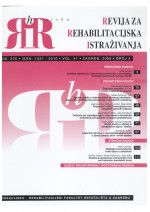Latentna struktura emergentne pismenosti u djece između pete i šeste godine
The latent structure of emergent literacy in children (aged 5 to 6)
Author(s): Branka D. JurišićSubject(s): Language acquisition, Preschool education, Cognitive Psychology, Developmental Psychology
Published by: Sveučilište u Zagrebu, Edukacijsko-rehabilitacijski fakultet
Keywords: emergent literacy; risk factors for reading difficulties; concepts of print; reading stages;
Summary/Abstract: The research object of this study was emergent literacy. The sample included 297 children between 5 and 6 years of age. The test of emergent literacy for preschool children was constructed. Factor analysis extracted five factors: decoding skills, letter knowledge, concepts of print, street environmental print and home environmental print. Children who are at risk for future reading difficulties are able to recognize environmental print before school entry, children who are not at that risk, are able to read words and short sentences because of their decoding skills and letter knowledge. Compared with the second group more children from the first group are from families with low SES. The test of emergent literacy presents a way of identifying children who should receive services in order to prevent reading difficulties before formal reading instruction at school.
Journal: Hrvatska revija za rehabilitacijska istrazivanja
- Issue Year: 40/2005
- Issue No: 2
- Page Range: 87-102
- Page Count: 16
- Language: Croatian

